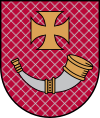Ventspils
| Ventspils | |||
|---|---|---|---|
| Town | |||

Ventspils Castle, built by the Livonian Order, and converted into a prison in 1832.
|
|||
|
|||
| Location in Latvia | |||
| Coordinates: 57°23′26″N 21°34′24″E / 57.39056°N 21.57333°E | |||
| Country | |||
| Town rights | 1378 | ||
| Government | |||
| • Mayor | none | ||
| Area | |||
| • Total | 55.4 km2 (21.4 sq mi) | ||
| Population (1 January 2017) | |||
| • Total | 39,286 | ||
| • Density | 710/km2 (1,800/sq mi) | ||
| Time zone | EET (UTC+2) | ||
| • Summer (DST) | EEST (UTC+3) | ||
| Postal code | LV-36(01-21) | ||
| Calling code | (+371) 636 | ||
| Number of city council members | 13 | ||
| Website | www |
||
Ventspils (Latvian: [ˈvæntspils]; German: Windau; Polish: Windawa; Livonian: Vǟnta) is a town in northwestern Latvia in the historical Courland region of Latvia, and is the sixth largest city in the country. At the beginning of 2017, Ventspils had a population of 39,286. It is situated on the Venta River and the Baltic Sea, and has an ice-free port. The city's name literally means "castle on the Venta", referring to the Livonian Order's castle built alongside the Venta River. Ventspils holds the national record for the highest temperature ever recorded in Latvia with 37.8 °C (100.0 °F) on 4 August 2014.
Ventspils developed around the Livonian Order Ventspils Castle, built along the Venta River. It was chartered in 1314 and became an important mercantile city of the Hanseatic League.
As part of the Duchy of Courland, Ventspils blossomed as a shipbuilding centre. 44 warships and 79 trading ships were built in the town, and it was from Ventspils that the Duke's fleet set out to colonize Gambia and Tobago. Metal, amber, and wood-working shops also became important to the city's development.
During the Polish-Swedish War and the Great Northern War, Ventspils was destroyed, and in 1711 a plague wiped out most of the remaining inhabitants. Ventspils fell under the control of Imperial Russia and its re-growth was stalled.
...
Wikipedia



